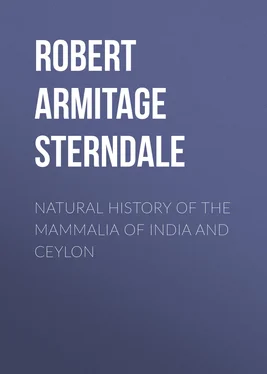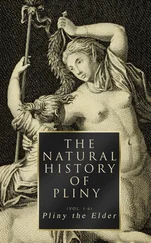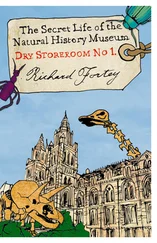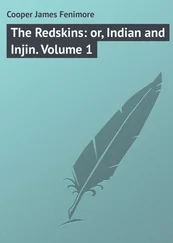Robert Armitage Sterndale - Natural History of the Mammalia of India and Ceylon
Здесь есть возможность читать онлайн «Robert Armitage Sterndale - Natural History of the Mammalia of India and Ceylon» — ознакомительный отрывок электронной книги совершенно бесплатно, а после прочтения отрывка купить полную версию. В некоторых случаях можно слушать аудио, скачать через торрент в формате fb2 и присутствует краткое содержание. Жанр: foreign_edu, Биология, на английском языке. Описание произведения, (предисловие) а так же отзывы посетителей доступны на портале библиотеки ЛибКат.
- Название:Natural History of the Mammalia of India and Ceylon
- Автор:
- Жанр:
- Год:неизвестен
- ISBN:нет данных
- Рейтинг книги:5 / 5. Голосов: 1
-
Избранное:Добавить в избранное
- Отзывы:
-
Ваша оценка:
- 100
- 1
- 2
- 3
- 4
- 5
Natural History of the Mammalia of India and Ceylon: краткое содержание, описание и аннотация
Предлагаем к чтению аннотацию, описание, краткое содержание или предисловие (зависит от того, что написал сам автор книги «Natural History of the Mammalia of India and Ceylon»). Если вы не нашли необходимую информацию о книге — напишите в комментариях, мы постараемся отыскать её.
Natural History of the Mammalia of India and Ceylon — читать онлайн ознакомительный отрывок
Ниже представлен текст книги, разбитый по страницам. Система сохранения места последней прочитанной страницы, позволяет с удобством читать онлайн бесплатно книгу «Natural History of the Mammalia of India and Ceylon», без необходимости каждый раз заново искать на чём Вы остановились. Поставьте закладку, и сможете в любой момент перейти на страницу, на которой закончили чтение.
Интервал:
Закладка:
Bewick, who was the first to figure and describe it, got, as the vulgar phrase hath it, the wrong pig by the lug, as he translates it Sand-bear . McMaster also speaks of those he saw as being in deep ravines on the Sitang river.
The stomach of Arctonyx is simple; there is no cæcum, as is the case also with the bears; the liver has five lobes; under the tail it has glands, as in the Badgers, secreting a fatty and odorous substance.
HABITAT.—Assam and Burmah.
DESCRIPTION.—Smaller than the last, with longer and finer fur, narrower muzzle, smaller ears, shorter tail, and more distinct markings. The measurement of the respective skulls show a great difference. The length of a skull of a female of this species given by Dr. Anderson is 4·75 inches against 6·38 of a female of A. collaris . The breadth across the zygomatic arch is 2·38 against 3·64 of A. collaris . The breadth of the palate between the molars is only 0·81 against 1·07.
This sub-genus is that of the American type of Badger, to which Hodgson, who first described the Thibetan T. leucurus , supposed his species to belong; but other recent naturalists, among whom are Drs. Gray and Anderson, prefer to class it as Meles . Hodgson founded his classification on the dentition of his specimen, but Blyth has thrown some doubt on its correctness, believing that the skull obtained by Hodgson with the skin was that of Meles albogularis . Hodgson, however, says: "from the English Badger type of restricted Meles our animal may be at once discriminated without referring to skulls by its inferior size, greater length of tail, and partially-clad planta or foot-sole."
NATIVE NAME.— Tampha .
HABITAT.—The plains of Thibet.
DESCRIPTION.—"Fur long, flaccid, dark iron-grey and white mixed; hair long, white, with a broad sub-lunate black band and a white tip; under fur abundant, long, white; a streak on each side of the forehead blackish grey, varied; chin, throat, legs and under side of the body black; tail, sides of head, and body whitish."— Gray .
The aspect, according to Hodgson, is entirely that of a long-tailed Badger (Gray remarks: "it most resembles the European animal "), with somewhat smaller head, with longer, finer fur than usual; the entire sole of the foot is not naked, but only about two-thirds, and the toe-pads are very much developed, thus raising the powerful long fossorial claws from the ground in walking.
SIZE.—Total length 37 inches, of which the tail, with the hair, is 10 inches, and without the hair 7 inches; the longest hair of the body is 4½ inches.
There is not much known about the Tampha . According to what Hodgson was able to gather concerning his habits, "he dwells in the more secluded spots of inhabited districts, makes a comfortable, spacious and well-arranged subterraneous abode, dwells there in peace with his mate, who has an annual brood of two to four young, molests not his neighbour, defends himself if compelled to it with unconquerable resolution, and feeds on roots, nuts, insects and reptiles, but chiefly the two former—on vegetables, not animals—a point of information confirmed by the prevalent triturant character of the teeth." The colouring of this animal is almost identical with the English badger, only that his tail is longer and whiter.
HABITAT.—Thibet.
DESCRIPTION.—Smaller and much less tufted ears than the last species; a shorter and much less bushy tail; and the fur shorter and coarser, though of finer texture than in the European badger, with much woolly hair at its base. Both the English badger and M. leucurus are black throated; this one is white throated. The English animal has a broad band of brownish-black, which begins between the muzzle and the eye, and runs through the eye and ear till it fades off on the neck; the space of white between these two bands on the forehead runs back and contracts behind the ears. In the Thibetan animal it contracts just behind the eyes, and is continued as a faint narrow streak only as far as the ears. In the English one the cheeks are broadly white between the eye-band and the black throat; in the Thibetan there is a little white below the eye, and this is bordered by a narrow black stripe, beneath which is the white throat.
There is another Thibetan badger mentioned by Professor Milne-Edwards in his 'Recherches sur les Mammifères,' a white-throated one, M. obscurus , but it appears to be the same as M. albogularis .
Tubercular grinder transverse; flesh-tooth larger, with a small internal lobe, and with a single tubercle; lower flesh-tooth tricuspidate, sharp-edged; head depressed; nose blunt; ears not visible externally; body stout, depressed; legs short, and strong; feet plantigrade, five-toed; front claws elongated and strong; the bald sole of the hind foot occupying the whole under surface, only slightly divided across about one-third of its length from the front; tail very short, with powerfully offensive glands; it has a thick loose skin and a subcutaneous layer of fat, which doubtless protect it from stings of bees, on which this genus is supposed to feed whenever it can.
NATIVE NAME.— Biju , Hind.; Biyu-khawar , Telegu; Tavakaradi , Tamil; Bajru-bhal , at Bhagulpore (Santali?); Bharsiah , Nepalese.
HABITAT.—Throughout India.

DESCRIPTION.—The upper half of its body is ashy-grey; the lower half, muzzle, limbs, and tail black; the general appearance is that of a black animal with a grey cloak on its back. The only difference between the Indian and the Cape Ratel is, that the grey cloak of the latter has a conspicuous white border which is wanting in the Indian species; the tail also of the latter is shorter, otherwise they are the same, and were for a long time considered the same.
SIZE.—Head and body, 26 to 32 inches; tail, 5 to 6 inches.
Jerdon says it is chiefly found in hilly districts, and that he has not found it in Lower Bengal nor on the Malabar coast. In Central India it is not uncommon. It has got a reputation for digging into graves, and is called in some parts "the grave-digger;" but I do not believe in its carnivorous propensities to this extent; it lives principally on small fry, insects, and small animals, honey and vegetable food. Jerdon says it is destructive to poultry, which is probable, for it will eat small birds. Both it and the Cape species will eagerly look out for bees, but it is not to be supposed, as some books would make out, that bees and honey form the staple diet. Its thick and loose skin, the stiffness of the hair above, and the layer of fat below, effectually preserve it from the effects of the stings. The tail glands contain a very strong and pungent secretion.
Some years ago, before I knew exactly what they were, the Ratels in the London Zoological Gardens used to interest me greatly. They had a low cage, on the ground I think, and their peculiar antics never failed to draw a crowd. They used to run round in an idiotic sort of way, and always at one point gravely turn head over heels and then proceed as before and repeat. In Cassell's 'Natural History' this is alluded to, only the writer says that now they are in fresh quarters, and the flitting seems to have disturbed them. He adds: "We have often watched one of them run round and round the cage in the usual purposeless manner of captive animals, but with this peculiarity: when he reached a particular corner of the den, he quietly, and without effort, turned head over heels, and then went on again. On one occasion, after he had been doing this with great regularity for some rounds he seemed to become abstracted, and passed the usual spot without the somersault; when, however, he had proceeded a few paces he recollected himself, stopped for a moment, returned to the exact place, turned over as usual, and proceeded without further let or hindrance." The African species is said to live largely on bees—I suppose ground bees, such as our English humble bee, for these animals are not arboreal—and it is said to exhibit great skill in tracking the flying insects to their nest. "Sparrman states that it seats itself on a hillock to look for the bees, and shades its eyes with one forepaw against the rays of the setting sun." Here is something for our Indian naturalists to observe. Some other animals are said to do the same; whether the Biju does it or not I cannot say. McMaster says of it: "Two that I saw in confinement appeared very good-tempered, and much more playful than tame bears would have been. They were, I think, fed entirely upon vegetables, rice and milk." This animal is the same as Hodgson's Ursitaxus inauritus , the Bharsiah which figures as a separate genus in Cuvier. The skull is very like that of the wolverenes in general form.
Читать дальшеИнтервал:
Закладка:
Похожие книги на «Natural History of the Mammalia of India and Ceylon»
Представляем Вашему вниманию похожие книги на «Natural History of the Mammalia of India and Ceylon» списком для выбора. Мы отобрали схожую по названию и смыслу литературу в надежде предоставить читателям больше вариантов отыскать новые, интересные, ещё непрочитанные произведения.
Обсуждение, отзывы о книге «Natural History of the Mammalia of India and Ceylon» и просто собственные мнения читателей. Оставьте ваши комментарии, напишите, что Вы думаете о произведении, его смысле или главных героях. Укажите что конкретно понравилось, а что нет, и почему Вы так считаете.












